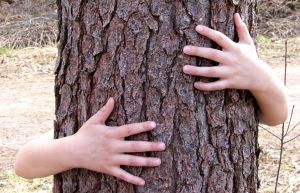Meet a Tree: A sweet observation activity
- Vicky Moore

- Jun 17, 2019
- 4 min read
Meet a Tree is a simple yet memorable partner activity, one you can do with just your family, on a retreat as a moment for mindfulness, or with school children as an anchor to center them, and teach them how to use their senses for observation as a tool to better know their surroundings. Your materials for this? A blindfold, and an optional nature journal to record the observations. This activity was first shared with me during a workshop through the Teton Science Schools, yet also appears in Sharing Nature With Children by Joseph Cornell, both are excellent resources worth exploring.
Beginning with partners, the partner who is the leader or the seeing partner leads the blindfolded one to a special tree. Be sure to check that this tree isn't crawling with poison ivy, with a wasp nest, or in a questionable location etc.. - common sense aside knowing their partner can't see, the leader selects a tree that is a bit unique. Usually the leaders guide them to a tree about 30 yards away from the starting point; however, with different ages and abilities the leader should adjust the distance to best suit their partner. You want it to be a bit challenging, without being daunting.

Once you meet the tree, the blindfolded partner uses their other senses, touch, smell, hearing to get to know this tree. They'll feel the texture of the tree’s bark, notice how big the tree is by putting her or his arms around it, reaching up high and dow low to get a sense of height, and explore the tree’s branches and leaves, are they pine needles, or soft supple leaves, are there flowers or a scent etc... The leader can also prompt their partner through silently guiding their hands to certain noteworthy places on the tree.
After getting to know their trees, the blindfolded players are brought back to the starting point, where their blindfolds are removed. You can either choose to go right into trying to find the tree after, or pause here, and use this moment as a reflective journaling time. With students this is a great moment to pause and with their nature journal to sketch what they think their tree might look like based upon their discovery meeting, and to write down any key descriptors. If doing this as a part of a specific learning activity, this is an excellent activity to work on descriptive language, challenging the students to write all the details, so that if someone was reading it, they too would have a sense of this tree. Was the tree narrow or wide, the bark fine or rough, smooth or bulky, the leaves prickly or soft etc... And the leader can journal about what it was like to guide someone on this activity, and if you have a tree identifying book with you, the guide, since they fully saw the tree, can use this time to try to identify the tree (without showing the blindfolded partner yet). Then, post journaling, the blind folded one walks with their guide partner to see if they can find their tree based upon solely their senses observation from before.
Sometimes you can just glance around the area and boom, spot your tree yards away. Other moments it takes 2 or 3 tries. Regardless, finding your tree after is just plain fun, like a mini treasure hunt, no matter your age or the number of times you have done this, you are meeting an old friend, just seeing him or her (yes as trees) for the first time.
Joseph Cornell in his sharings on this activity notes that a teacher in Japan tells the children, “In this forest there is a tree that has been waiting to meet you since before you were born,” as part of the framing activity for this activity. He goes on to share that the students are always so touched by these words, that they are honored and eager to befriend and feel and know their tree.
With young children, as this is a blindfolded activity, I'd start around age 8 and model it first for the group and set up safety parameters regarding your location outdoors, being mindful of the partner pairings. If the basic idea of set up for outdoor safety with group learning is new to you, please drop me a message (email here). It would be another post entirely, yet outdoor learning safety structures are important for this game, especially if done with a large group of kiddos.
I've also though done this with my 2.5 yr old son, yet highly modified. No blindfold, we find a tree, smell the tree, feel the tree, hug the tree, notice as much as we can about the tree, name the tree etc... then go off and play and when we return see if we can find our friend we just met through "Meet a Tree Toddler Style." We may use clues that one wouldn't get with the blindfold, such as our tree was near a bush we saw, or by a familiar rock, details we noticed with our eyes. In these moments instead of thinking what we are missing by not using the blindfold, I think of what we are experiencing and sharing together. For young, young little ones, observing, remembering, problem solving, communicating and using their words to describe their process, creating a connection with nature ... this all is rich and so valuable and laying a foundation to engage with deeper more complex outdoor learning later on.
If you'd like to partner this activity with a deeper Tree Study, check out our Tree themed Picture Book Companions for ages 2-12 here.
below poem by Mary Oliver


















Comments